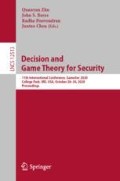Abstract
In this work we consider the problem of defending against adversarial attacks from UAV swarms performing complex maneuvers, driven by multiple, dynamically changing, leaders. We rely on short-time observations of the trajectories of the UAVs and develop a leader detection scheme based on the notion of Granger causality. We proceed with the estimation of the swarm’s coordination laws, modeled by a generalized Cucker-Smale model with non-local repulsive potential functions and dynamically changing leaders, through an appropriately defined iterative optimization algorithm. Similar problems exist in communication and computer networks, as well as social networks over the Internet. Thus, the methodology and algorithms proposed can be applied to many types of network swarms including detection of influential malevolent “sources” of attacks and “miss-information”. The proposed algorithms are robust to missing data and noise. We validate our methodology using simulation data of complex swarm movements.
This work was partially supported by the Defense Advanced Research Projects Agency (DARPA) under Agreement No. HR00111990027, by ONR grant N00014-17-1-2622, and by a grant from Northrop Grumman Corporation.
Access this chapter
Tax calculation will be finalised at checkout
Purchases are for personal use only
References
Bajec, I.L., Heppner, F.H.: Organized flight in birds. Anim. Behav. 78(4), 777–789 (2009)
Ballerini, M., et al.: Interaction ruling animal collective behavior depends on topological rather than metric distance: evidence from a field study. Proc. Natl. Acad. Sci. 105(4), 1232–1237 (2008)
Banerjee, A., Merugu, S., Dhillon, I.S., Ghosh, J.: Clustering with Bregman divergences. J. Mach. Learn. Res. 6(Oct), 1705–1749 (2005)
Bongard, J., Lipson, H.: Automated reverse engineering of nonlinear dynamical systems. Proc. Natl. Acad. Sci. 104(24), 9943–9948 (2007)
Brunton, S., Proctor, J., Kutz, J.: Discovering governing equations from data by sparse identification of nonlinear dynamical systems. Proc. Natl. Acad. Sci. 113(15), 3932–3937 (2016)
Carmi, A.Y., Mihaylova, L., Septier, F., Pang, S.K., Gurfil, P., Godsill, S.J.: MCMC-based tracking and identification of leaders in groups. In: 2011 IEEE International Conference on Computer Vision Workshops (ICCV Workshops), pp. 112–119 (2011)
Carrillo, J., Fornasier, M., Toscani, G., Vecil, F.: Particle, Kinetic, and Hydrodynamic Models of Swarming. Birkhäuser Boston, Boston (2010)
Cucker, F., Smale, S.: Emergent behavior in flocks. IEEE Trans. Autom. Control 52(5), 852–862 (2007)
Giardina, I.: Collective behavior in animal groups: theoretical models and empirical studies. HFSP J. 2(4), 205–219 (2008)
Granger, C.W.J.: Investigating causal relations by econometric models and cross-spectral methods. Econometrica 37(3), 424–438 (1969). http://www.jstor.org/stable/1912791
Ha, S.Y., Liu, J.G., et al.: A simple proof of the Cucker-Smale flocking dynamics and mean-field limit. Commun. Math. Sci. 7(2), 297–325 (2009)
Hamilton, J.: Time Series Analysis. Princeton University Press (1994). https://books.google.com/books?id=B8_1UBmqVUoC
Jaynes, E.T.: Information theory and statistical mechanics. Phys. Rev. 106(4), 620 (1957)
Kingma, D.P., Ba, J.: Adam: a method for stochastic optimization. arXiv preprint arXiv:1412.6980 (2014)
Kirkpatrick, S., Gelatt, C.D., Vecchi, M.P.: Optimization by simulated annealing. Science 220(4598), 671–680 (1983)
Lu, F., Zhong, M., Tang, S., Maggioni, M.: Nonparametric inference of interaction laws in systems of agents from trajectory data. arXiv preprint arXiv:1812.06003 (2018)
Maclaurin, D., Duvenaud, D., Johnson, M., Townsend, J.: Autograd (2018). https://github.com/HIPS/autograd
Mao, Z., Li, Z., Karniadakis, G.: Nonlocal flocking dynamics: learning the fractional order of PDEs from particle simulations. arXiv preprint arXiv:1810.11596 (2018)
Matei, I., de Kleer, J., Minhas, R.: Learning constitutive equations of physical components with constraints discovery. In: 2018 Annual American Control Conference (ACC), pp. 4819–4824, June 2018. https://doi.org/10.23919/ACC.2018.8431510
Matei, I., Mavridis, C., Baras, J.S., Zhenirovskyy, M.: Inferring particle interaction physical models and their dynamical properties. In: 2019 IEEE Conference on Decision and Control (CDC), pp. 4615–4621. IEEE (2019)
Mavridis, C.N., Baras, J.S.: Convergence of stochastic vector quantization and learning vector quantization with Bregman divergences. In: 21rst IFAC World Congress. IFAC (2020)
Mavridis, C.N., Tirumalai, A., Baras, J.S.: Learning interaction dynamics from particle trajectories and density evolution. In: 2020 59th IEEE Conference on Decision and Control (CDC). IEEE (2020)
Mavridis, C.N., Tirumalai, A., Baras, J.S., Matei, I.: Semi-linear Poisson-mediated flocking in a Cucker-Smale model. In: 24th International Symposium on Mathematical Theory of Networks and Systems (MTNS). IFAC (2021)
Mavridis, C.N., Vrohidis, C., Baras, J.S., Kyriakopoulos, K.J.: Robot navigation under MITL constraints using time-dependent vector field based control. In: 2019 IEEE 58th Conference on Decision and Control (CDC), pp. 232–237. IEEE (2019)
Okubo, A.: Dynamical aspects of animal grouping: swarms, schools, flocks, and herds. Adv. Biophys. 22, 1–94 (1986)
Paszke, A., et al.: Automatic differentiation in PyTorch (2017)
Reynolds, C.: Flocks, herds and schools: a distributed behavioral model. In: ACM SIGGRAPH Computer Graphics, vol. 21, pp. 25–34. ACM (1987)
Rose, K.: Deterministic annealing for clustering, compression, classification, regression, and related optimization problems. Proc. IEEE 86(11), 2210–2239 (1998). https://doi.org/10.1109/5.726788
van der Schaft, A., Jeltsema, D.: Port-Hamiltonian systems theory: an introductory overview. Foundations Trends\({\textregistered }\) Syst. Control 1(2–3), 173–378 (2014). https://doi.org/10.1561/2600000002
Theodorakopoulos, G., Baras, J.S.: On trust models and trust evaluation metrics for ad hoc networks. IEEE J. Sel. Areas Commun. 24(2), 318–328 (2006)
Will, T.E.: Flock leadership: understanding and influencing emergent collective behavior. Leadersh. Q. 27(2), 261–279 (2016). https://doi.org/10.1016/j.leaqua.2016.01.002, http://www.sciencedirect.com/science/article/pii/S1048984316000035. Special Issue: Collective and Network Approaches to Leadership
Author information
Authors and Affiliations
Corresponding author
Editor information
Editors and Affiliations
Rights and permissions
Copyright information
© 2020 Springer Nature Switzerland AG
About this paper
Cite this paper
Mavridis, C.N., Suriyarachchi, N., Baras, J.S. (2020). Detection of Dynamically Changing Leaders in Complex Swarms from Observed Dynamic Data. In: Zhu, Q., Baras, J.S., Poovendran, R., Chen, J. (eds) Decision and Game Theory for Security. GameSec 2020. Lecture Notes in Computer Science(), vol 12513. Springer, Cham. https://doi.org/10.1007/978-3-030-64793-3_12
Download citation
DOI: https://doi.org/10.1007/978-3-030-64793-3_12
Published:
Publisher Name: Springer, Cham
Print ISBN: 978-3-030-64792-6
Online ISBN: 978-3-030-64793-3
eBook Packages: Computer ScienceComputer Science (R0)

